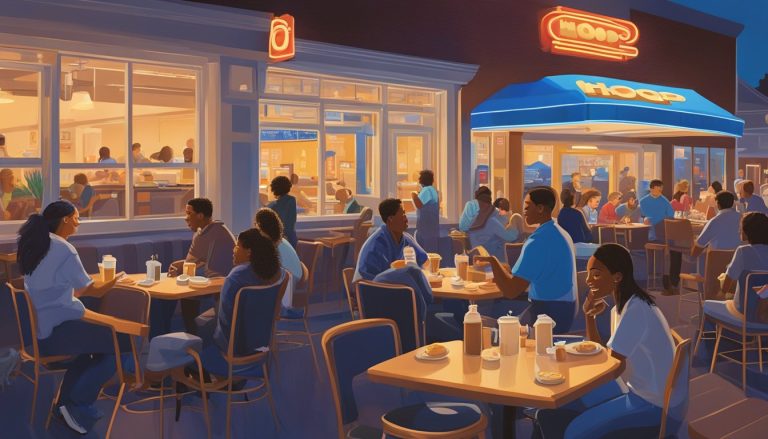In June 2018, IHOP shocked the restaurant industry and social media by announcing a temporary name change to IHOb. The International House of Pancakes flipped its iconic “P” to a “B” to promote its new line of burgers. This unexpected move sparked widespread curiosity and debate.
The IHOb campaign quadrupled burger sales for the chain in just 10 days. Over 1.2 million tweets and 2.1 million social media conversations erupted about the rebrand. Major brands like Wendy’s jumped into the fray with witty responses, further fueling public interest.
IHOP’s bold marketing stunt successfully shifted attention to its expanded menu offerings beyond breakfast. The pancake purveyor proved it could compete in the crowded burger market while generating massive buzz. Though short-lived, the IHOb experiment demonstrated the power of a well-executed publicity campaign to drive sales and brand awareness.
Background of IHOP and the IHOB Concept
IHOP, a beloved breakfast chain, surprised the world with its temporary transformation into IHOB. This bold move aimed to highlight the restaurant’s burger offerings and create buzz around the brand.
Origins and Brand Identity of IHOP
The International House of Pancakes (IHOP) began in 1958 with a simple yet innovative concept: a restaurant dedicated to serving a variety of pancakes and breakfast dishes from around the world. This idea quickly gained popularity, leading to rapid expansion through franchising by 1960.
IHOP’s brand identity centered around breakfast, particularly pancakes. The chain became known for its diverse menu and family-friendly atmosphere. Over the years, IHOP introduced successful promotions like the Rooty Tooty Fresh ‘N Fruity in 1985, solidifying its place in American dining culture.
By the 1990s, IHOP had established itself as a pancake giant with a strong breakfast-focused brand image.
The Announcement of IHOB and Its Implications
On June 11, 2018, IHOP made a startling announcement on its official Instagram account: “We’re flippin’ from pancakes, pancakes, pancakes to burgers, burgers, burgers. #IHOb.” This post marked the temporary change of IHOP to IHOB, with the “b” standing for burgers.
The announcement created significant buzz and confusion among customers and media outlets. Many wondered if this was a permanent change or a marketing stunt.
This move had several implications:
- It challenged the brand’s established identity
- It aimed to draw attention to IHOP’s less-known menu items
- It sparked conversations about the chain’s marketing strategy
Rebranding Strategy: A Glimpse into IHOB
The IHOB rebranding was a strategic move to highlight IHOP’s burger offerings. While the chain had always served burgers, they were often overshadowed by breakfast items.
Key aspects of the rebranding included:
- Flipping the “P” to a “b” in the logo
- Introducing new burger options
- Launching a widespread marketing campaign
This temporary change lasted only a few weeks but generated significant media coverage and social media engagement. It demonstrated IHOP’s willingness to take risks and adapt to changing consumer preferences.
The IHOB experiment showcased the power of creative marketing in revitalizing a well-established brand. It successfully brought attention to IHOP’s diverse menu beyond breakfast items.
The IHOB Campaign Unveiled
IHOP’s temporary transformation into IHOb marked a bold marketing move that captivated audiences and sparked widespread conversation. The campaign leveraged social media, strategic publicity, and carefully crafted messaging to generate buzz around the brand’s expanded menu offerings.
Marketing Strategy and Execution
IHOP orchestrated a multi-faceted marketing approach to introduce its new burger-centric identity. The company teased the change on social media platforms, creating anticipation and speculation about the meaning behind the “b” in IHOb. This strategy successfully piqued public curiosity.
The campaign centered on a temporary name change, with select restaurant locations physically altering their signage to display “IHOb” instead of “IHOP”. This visual transformation reinforced the message across both digital and physical spaces.
IHOP’s marketing team coordinated the rollout across various channels, ensuring consistent messaging and timing. The campaign’s execution balanced humor with a serious commitment to highlighting the brand’s expanded menu options.
Social Media Buzz and Audience Engagement
Twitter became the primary battleground for the IHOb campaign, with the platform serving as a hub for viral content and real-time reactions. IHOP’s initial tweet announcing the change garnered significant attention, receiving 21,000 likes within seven hours.
Competitor brands quickly joined the conversation, with Wendy’s response gaining over 96,000 likes in half that time. This engagement from other companies amplified the campaign’s reach and sparked playful banter that further entertained audiences.
The social media strategy successfully generated 36 billion earned media impressions and reached a potential audience of more than 4 billion people. The campaign trended at #1, #2, and #5 nationally on Twitter, demonstrating its widespread impact.
Press Releases and Public Statements
IHOP issued official press releases to explain the reasoning behind the IHOb campaign. These statements emphasized the company’s commitment to expanding its lunch and dinner offerings while maintaining its breakfast heritage.
The brand’s public messaging clarified that the name change was temporary, designed to highlight new menu items. IHOP executives gave interviews to media outlets, providing context for the campaign and discussing its goals.
Press materials included details about the new burger options, positioning them as high-quality additions to the menu. The company used these communications to reassure loyal customers that pancakes remained a core part of IHOP’s identity.
Consumer and Industry Reaction
IHOP’s temporary transformation to IHOb sparked widespread reactions from customers, competitors, and industry observers. The bold marketing move generated significant buzz across social media platforms and elicited responses from rival fast-food chains.
Feedback from Customers and Fans
The IHOb campaign ignited a social media frenzy. In the first 10 days following the announcement, over 1.2 million tweets mentioned the brand and its burgers. The total social media conversations about IHOb surpassed 2.1 million.
Many customers expressed surprise and confusion at the sudden shift. Some embraced the change with enthusiasm, eager to try IHOP’s new burger offerings. Others voiced disappointment, fearing the loss of their beloved pancakes.
Twitter became a hotbed of IHOb discussions, with users sharing memes, jokes, and opinions about the rebranding.
Competitors’ Responses to the IHOB Move
Rival fast-food chains seized the opportunity to join the conversation, often with humorous jabs at IHOP’s expense.
Burger King temporarily changed its Twitter name to “Pancake King,” playfully mocking IHOP’s pivot to burgers. Wendy’s, known for its witty social media presence, tweeted: “Not really afraid of the burgers from a place that decided pancakes were too hard.”
These responses further amplified the campaign’s reach, creating a ripple effect across the fast-food industry’s social media landscape.
Impact on the Brand and Industry Perception
The IHOb campaign successfully increased brand awareness and sparked curiosity about IHOP’s burger offerings. Despite initial skepticism, the move proved effective in driving sales.
IHOP reported that burger sales quadrupled following the campaign launch. The publicity generated by the name change and subsequent social media buzz translated into tangible business results.
Industry observers noted the campaign’s success in reinvigorating the IHOP brand and expanding its perceived menu offerings beyond breakfast items. The bold marketing strategy demonstrated the power of social media engagement and the potential impact of temporary rebranding initiatives.
Menu Transformation and Product Offering

IHOP’s temporary transformation to IHOb marked a significant shift in their menu strategy. The move expanded their offerings beyond breakfast staples to include a variety of new burger options.
From Pancakes to Burgers: Diversifying the Menu
IHOP introduced a new line of Ultimate Steakburgers to complement their existing breakfast menu. This expansion aimed to attract lunch and dinner customers, broadening the restaurant’s appeal beyond its traditional breakfast and brunch crowd. The burger offerings included 100% USDA choice, black angus beef patties, positioning IHOP as a competitor in the quick-service burger market.
The menu diversification allowed IHOP to cater to different meal times and customer preferences. While maintaining their pancake heritage, the addition of burgers provided more options for lunch and dinner diners.
Introducing New Burger Varieties
IHOP launched seven distinct burger varieties as part of their IHOb campaign. These included:
- Classic burger with lettuce, tomato, and onion
- Mushroom and Swiss burger
- Jalapeno Kick burger
- Big Brunch burger topped with a fried egg
- Mega Monster burger with two patties
Each burger was served on a brioche bun and came with a side of French fries. The variety aimed to cater to different taste preferences and compete with established burger chains.
Assessment of Menu Performance Post-Campaign
The introduction of burgers to IHOP’s menu had mixed results. Initial buzz generated increased foot traffic and social media engagement. However, long-term performance data on burger sales remains limited.
Some customers appreciated the expanded menu options, while others felt the move diluted IHOP’s brand identity. The campaign’s impact on pancake sales is unclear, but it did succeed in raising awareness of IHOP’s lunch and dinner offerings.
IHOP eventually reverted to its original name but kept the new burger items on the menu. This suggests the menu expansion had some success in diversifying the restaurant’s appeal beyond breakfast hours.
Business Outcomes and Analysis
IHOP’s temporary rebrand to IHOb yielded significant short-term gains but also raised questions about long-term brand implications. The campaign’s impact on sales, market perception, and overall brand health varied across different timeframes and metrics.
Sales and Financial Performance Post-IHOB
IHOP experienced a substantial boost in burger sales following the IHOb campaign. Burger sales quadrupled in the immediate aftermath of the name change. This surge in burger orders contributed to improved overall sales figures for the company.
The promotion’s success extended beyond just burgers. IHOP saw increased foot traffic and heightened interest in its menu offerings across the board. The buzz generated by the campaign translated into tangible financial gains for the company in the short term.
Dine Brands Global, IHOP’s parent company, reported positive financial results in the quarters following the IHOb promotion. The campaign’s ability to drive sales and attract new customers played a role in these improved financial metrics.
Market Reception and Wall Street Reaction
Wall Street initially responded with caution to IHOP’s unconventional marketing strategy. Some analysts questioned the wisdom of potentially diluting a well-established brand identity.
As the campaign’s results became clear, market sentiment shifted. The significant increase in sales and brand engagement led to a more positive outlook from investors and analysts.
IHOP’s stock price saw modest gains in the weeks following the campaign, reflecting improved market confidence in the company’s ability to innovate and drive growth.
The marketing strategy garnered praise from industry experts for its boldness and effectiveness in cutting through the noise of traditional advertising.
Analysis of Long-Term Brand Health
The IHOb campaign’s long-term impact on IHOP’s brand health was mixed. On one hand, it successfully broadened the brand’s appeal beyond breakfast and pancakes, potentially opening up new revenue streams.
Brand awareness and social media engagement metrics showed substantial improvements. The campaign generated over 1.2 million tweets and 2.1 million social media conversations in just 10 days, significantly increasing IHOP’s digital footprint.
However, some brand experts expressed concern about potential confusion among long-time customers. The temporary nature of the rebrand helped mitigate these concerns, allowing IHOP to retain its core identity while exploring new market opportunities.
Post-campaign surveys indicated a slight shift in consumer perception, with more people associating IHOP with a diverse menu rather than just pancakes. This broadened brand association could prove beneficial for future menu expansions and marketing initiatives.
Lessons Learned from the IHOB Experiment
The IHOB campaign provided valuable insights for marketers and brands considering bold promotional moves. It highlighted the power of unexpected tactics to generate buzz, while also revealing potential pitfalls of temporary rebranding efforts.
Effectiveness of Marketing Stunts in Branding
The IHOB experiment demonstrated the immense potential of marketing stunts to capture public attention. By temporarily changing its name, IHOP created a social media frenzy and extensive media coverage. This move effectively put the brand at the center of conversations across platforms.
The campaign’s success in generating buzz underscored the value of surprise and novelty in marketing. It showed how breaking away from established brand norms can pique curiosity and engagement.
However, the long-term impact on brand perception remained unclear. While it boosted short-term awareness, some questioned whether it strengthened or diluted the brand’s core identity as a breakfast destination.
Evaluating the Risks and Rewards of Bold Brand Moves
IHOP’s rebranding gamble highlighted both opportunities and challenges of dramatic marketing tactics. On the positive side, it showcased the brand’s willingness to innovate and adapt to changing consumer preferences.
The campaign successfully drew attention to IHOP’s expanded menu offerings, particularly its burger line. This helped broaden public perception of the restaurant beyond just breakfast fare.
However, the stunt also risked confusing loyal customers and potentially alienating those who valued IHOP’s traditional image. The temporary nature of the change mitigated some risks, but still posed challenges in maintaining brand consistency.
Future Implications for Brand Campaigns in the Restaurant Industry
The IHOB experiment set a precedent for creative marketing in the restaurant sector. It demonstrated that even established chains can benefit from unconventional promotional strategies.
Social media emerged as a crucial battleground for brand visibility. The campaign’s viral nature highlighted the importance of crafting shareable, discussion-worthy content.
Moving forward, restaurants may increasingly experiment with limited-time promotions or menu changes to generate buzz. However, they’ll need to balance innovation with maintaining their core brand identity and customer expectations.
The IHOB case also emphasized the need for clear communication in marketing stunts. Brands must ensure that temporary changes don’t overshadow their long-term positioning or confuse their target audience.




